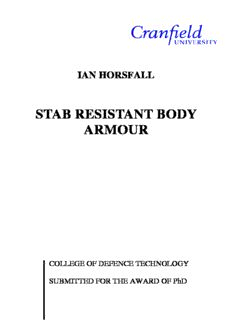
stab resistant body armour PDF
Preview stab resistant body armour
IAN HORSFALL STAB RESISTANT BODY ARMOUR COLLEGE OF DEFENCE TECHNOLOGY SUBMITTED FOR THE AWARD OF PhD CRANFIELD UNIVERSITY ENGINEERING SYSTEMS DEPARTMENT SUBMITTED FOR THE AWARD OF PhD 1999-2000 IAN HORSFALL STAB RESISTANT BODY ARMOUR SUPERVISOR DR M. R. EDWARDS MARCH 2000 ©Cranfield University, 2000. All rights reserved. No part of this publication may be reproduced without the written permission of the copyright holder. ABSTRACT There is now a widely accepted need for stab resistant body armour for the police in the UK. However, very little research has been done on knife resistant systems and the penetration mechanics of sharp projectiles are poorly understood. This thesis explores the general background to knife attack and defence with a particular emphasis on the penetration mechanics of edged weapons. The energy and velocity that can be achieved in stabbing actions has been determined for a number of sample populations. The energy dissipated against the target was shown to be primarily the combined kinetic energy of the knife and the arm of the attacker. The compliance between the hand and the knife was shown to significantly affect the pattern of energy delivery. Flexibility and the resulting compliance of the armour was shown to have a significant effect upon the absorption of this kinetic energy. The ability of a knife to penetrate a variety of targets was studied using an instrumented drop tower. It was found that the penetration process consisted of three stages, indentation, perforation and further penetration as the knife slides through the target. Analysis of the indentation process shows that for slimmer indenters, as represented by knives, frictional forces dominate, and indentation depth becomes dependent upon the coefficient of friction between indenter and sample. Analytical models are demonstrated to provide a reasonable estimate of energy absorption during and after penetration for a wide variety of knives and armour materials. The key armour parameters are shown to be the frictional interaction with the blade and the strength of the target material. The performance of knife blades is shown to increase with increasing sharpness, slimness, and surface finish. No single knife design performs best against all types of armour, and no single armour is best against all knife blades. I II ACKNOWLEDGEMENTS I would like to acknowledge the support of the Police Scientific Development Branch of the Home Office (PSDB) for supporting this work under contracts PITO 96/17/206/2/c, 98/17/038/2/c, and 99/17/139/2/c, with particular thanks to Gill Tan, Martin Pettit, John Croft, and Tim Thomas for their advice and encouragement. I would also like to thank the director of PSDB, Brian Coleman, for his kind permission to reproduce the PSDB Stab Resistance Standard For Body Armour in appendix 1 of this thesis. I am indebted to Celia Watson, for her persistent and unending technical and moral support of both me and this research. I would also like to thank Steve Champion and Ian Harrod, for their help in completing this work. I would like to thank David Sim of the University of Reading for his help and advice with the historical section of chapter 3. Numerous students have contributed to related areas of this research, and I am grateful for their contributions. In particular, I would like to thank Stephanie Pollitt who started the original work, which led to this programme and without whose enthusiasm this work might never have started. I would like to thank Mike Edwards for his extremely thorough and timely supervision of this thesis and for his help in its final preparation and presentation. Finally I would like to thank my wife Jackie for her encouragement and patience during the long gestation period of this thesis. III IV CONTENTS CHAPTER 1 -INTRODUCTION 1 CHAPTER 2 -LITERATURE REVIEW 5 2.1 INTRODUCTION 5 2.2 THE THREAT 6 2.3 TEST STANDARDS 10 2.4 METAL FORMING PROCESSES 16 2.5 BALLISTIC PENETRATION 21 2.6 PREVIOUS EXPERIMENTAL WORK (RMCS) 26 2.7 CONCLUSIONS 32 2.8 REFERENCES 33 CHAPTER 3 -SURVEY OF KNIFE ARMOUR TECHNOLOGY 37 3.1 INTRODUCTION 37 3.2 HISTORICAL TECHNOLOGY 37 3.3 A REVIEW OF PATENTS 51 3.4 DISCUSSION 58 3.5 CONCLUSIONS 61 3.6 TABLE OF KNIFE ARMOUR AND RELATED PATENTS 62 3.7 BIBLIOGRAPHY 66 3.8 REFERENCES 66 V CHAPTER 4 - EMPIRICAL STUDY OF ARMOUR AND KNIVES 69 4.1 INTRODUCTION 69 4.2 TEST METHODS 69 4.3 INITIAL TRIALS 75 4.4 SECOND STUDY – KEY VARIABLES 78 4.5 THIRD STUDY – DATA GATHERING 85 4.6 DISCUSSION 105 4.7 CONCLUSION 111 4.8 REFERENCES 113 CHAPTER 5 - HUMAN PERFORMANCE 115 5.1 INTRODUCTION 115 5.2 EXPERIMENTAL TRIALS PROCEDURE 116 5.3 TRIALS RESULTS 119 5.4 DISCUSSION OF TRIALS 122 5.5 ANALYSIS OF HAND STABS 126 5.6 CONCLUSIONS 136 5.7 REFERENCES 137 CHAPTER 6 - PENETRATION MECHANICS - INDENTATION 139 6.1 INTRODUCTION 139 6.2 INDENTATION THEORY 139 6.3 EXPERIMENTAL 141 6.4 DISCUSSION 153 6.5 CONCLUSIONS 155 6.6 REFERENCES 156 VI CHAPTER 7 - PENETRATION MECHANICS 157 7.1 INTRODUCTION 157 7.2 ANALYTICAL MODELS 158 7.3 VALIDATION OF ANALYTICAL MODELS 167 7.4 DISCUSSION 176 7.5 CONCLUSIONS 179 7.6 REFERENCES 179 CHAPTER 8 – GENERAL DISCUSSION 181 8.1 INTRODUCTION 181 8.2 TECHNOLOGICAL AND HISTORICAL BACKGROUND 182 8.3 INDENTATION 186 8.4 PENETRATION ANALYSIS 194 8.5 HUMAN PERFORMANCE 196 8.6 DYNAMIC INTERACTIONS 200 8.7 CONCLUSIONS 205 8.8 REFERENCES 206 CHAPTER 9 – CONCLUSIONS 209 CHAPTER 10 – RECOMENDATIONS FOR FUTURE WORK 213 VII
Description: